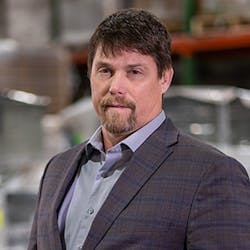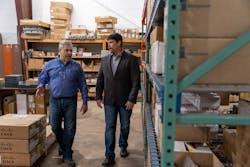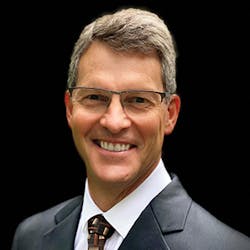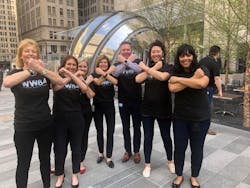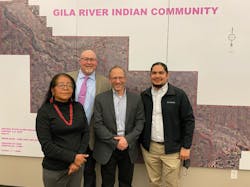Executive Insights with ISE EXPO’s Tech Talk Presenters
Leaders from AT&T, Consolidated Communications, Inc., NTCA and TDS Telecom Offer a Sneak Peek Into Their Tech Talk Topics and Network Transformation Priorities
Learn from four network transformation leaders who have walked in your shoes and have the best practices to prove it:
- Ben Goth, Vice President of Network Services, TDS Telecom
- Troy Johnson, Vice President of Network Engineering, Consolidated Communications, Inc.
- Kevin McDorman, Vice President, Customer Care, AT&T
- Joshua Seidemann, Vice President of Policy, NTCA – The Rural Broadband Association
“Solutions developed and commonly used in high density fiber builds do little to help enable customers in less dense areas with fiber. The designs and traditional build methods must be changed to reduce complexity and decrease the cost and time to implement fiber solutions.”
Topic: Your Passion
Share one problem/challenge you are passionate about solving for the ICT Industry.
At TDS Telecom, we are passionate about driving change to deliver fiber to as many customers as possible. We are striving for changes and process refinements at every level in the fiber ecosystem to make enabling as many customer connections as possible faster. Solutions developed and commonly used in high density fiber builds do little to help enable customers in less dense areas with fiber. The designs and traditional build methods must be changed to reduce complexity and decrease the cost and time to implement fiber solutions. We must repeatedly look at every step in the process, questioning how it is done and why it is required to find opportunities for efficiencies.
Topic: Your Tech Talk at ISE EXPO 2022
What is the topic of your Tech Talk at ISE EXPO and why should our readers attend it live?
The primary solution to every network problem is building fiber economically. This is a change in mindset for all teams to make sure the entire organization is focused on the best long-term solution, and it is implemented when it is also economically feasible. The teams must be able to accurately forecast customer and utilization growth so there is proper alignment with the time to implement a fiber solution. Forecasted network problems related to equipment space, port capacity, heating, cooling, etc. have typically been evaluated within the teams responsible for those disciplines.
For example, we have driven our teams to look for a solution to a forecasted cooling problem by finding ways to reduce the cooling needs through fiber deployments and removing equipment that needs to be cooled. Designing and estimating the costs of upgrading a cooling system is well understood, which allows for an easy comparison to other solutions developed by those in other disciplines.
Topic: Priorities
What’s the biggest challenge you’re facing in your role right now and what are a few ways to tackle it that others can borrow as they face a similar problem?
The biggest challenge is finding the best resources to complete the right projects. We have worked to find the appropriate construction and engineering partners to do the necessary work. As our designs and build methods change, we must determine where we can move to using different partners with specialized skills to accelerate and complete builds. Conversely, if you choose a partner that doesn’t work out, you lose time and money as well as the competitive advantage in a market.
Topic: Labor Challenges
The US telecommunications industry employs a total of 672,000 workers, with average annual wages of $77,500. It’s forecasted that 5G rollout and other technologies could create 850,000 more "new direct broadband and 5G jobs" through 2025.
Many in the US telecom network construction sector argue it’s difficult finding enough skilled workers to deploy fiber and 5G networks. In response, CSPs must embrace creative field solutions to deliver gigabit speeds to end-users sooner than later.
Share a few of your favorite strategies/tools/tactics that help your teams succeed given these labor challenges.
My team partners heavily with our supply chain services organization. We scour our partners to find those with the desire to expand, grow and collaborate to help them also grow and expand. This approach requires a strong series of relationships and trust to ensure all needs are met. Our partners in SCS are great at understanding the needs of the partner company and making sure fulfilling those needs aligns with the requirements of both businesses.
Topic: Customer Care
Companies that prioritize innovation and care in redesigning customer experiences will be best positioned to stay ahead of shifting consumer preferences.
Share two of your top customer-centric tactics that other providers could borrow.
TDS Telecom takes customer service seriously, especially in our out-of-territory fiber projects. Construction can be disruptive and upset some potential customers. We have a dedicated customer hotline staffed to field questions and concerns during this construction period. It’s effective and it works. Secondly, we try to meet our customers where they want to communicate–whether it is online, phone, social media or face-to-face at community events or even at their door so they can learn about our products and services directly.
Read on for additional topics discussed with Ben (not covered in ISE Magazine's July print issue).
Topic: Energy*
If energy were free, (and we’re not talking power), what would your team do differently?
Fortunately, at TDS Telecom, I wouldn’t change anything with our approach. Our teams are unified and energized around our goal of expanding fiber to new markets quickly. What helps is that we have strong support from senior leaders and TDS corporate. We are driven to accomplish more than we ever have in the past and I’m proud of the work that my team is doing to achieve our objectives.
*Question Source: Tony Hsieh, CEO of Zappos via www.inc.com
Topic: In Pursuit of Knowledge
What’s the best book you’ve read this year?
Measure What Matters by John Doerr. The book talks about using Objects and Key Results (OKRs) to drive performance. I would recommend the book and the goal-setting approach to others in leadership positions.
Topic: The Great Relearning Trend
While the Great Resignation is all over the news, a lesser publicized trend is about a renewed desire in learning. Record numbers of people are on a mission to upskill and remain relevant in this new work-from-anywhere world. Enrollment in "massive open online courses" has skyrocketed according to the Navigating ‘The Great Relearning’ Revolution article.
E-learning is an obvious solution of course. What other ways should leaders support their team members’ search for learning and desire to become more relevant?
The tight labor market is forcing companies to be even more creative in retaining and retraining workers. Associates need to feel like there is an avenue to advance in their companies or they may look elsewhere. TDS Telecom recently increased its education assistance program to cover 100% tuition reimbursement. We are also increasing and expanding associate participation in what we call TDS University where selected employees have the opportunity for a three-year rotation in various positions around the company.
Topic: Network Sustainability
BCG estimates that action by the ICT industry could eliminate up to 15% of all global emissions by 2030, more than a third of the total emissions reductions needed to meet global sustainability targets. In total, 12.1 gigatons of CO2 could be saved, which would equate to $6.5 trillion.
What is your company doing across the network to help hit these aggressive sustainability targets?
TDS Telecom, along with its corporate parent and sister companies, is actively working on ways to use less energy to perform the same tasks, which will help reduce costs, reduce carbon emissions, and reduce risk. We are not only tracking and monitoring energy to conserve usage in our facilities, but we’re also examining how we conduct our business. We recently completed a project to improve energy efficiency at our headquarters in Madison, Wisconsin. The results were positive, and TDS was recognized for the third year in a row at the 2021 Rocky Mountain Institute Utility and Exchange Conference for our sustainability efforts.
Sources:
Putting Sustainability at the Top of the Telco Agenda
https://www.bcg.com/en-us/about/partner-ecosystem/world-economic-forum/ceo-guide-net-zero
Topic: 5G
Clearly, not every CSP is a wireless carrier. However, we all know that 5G is fueled by fiber and CSPs must deploy fiber to thrive in a competitive marketplace.
What is your organization doing in terms of network evolution to help support 5G rollout to underserved areas?
As 5G grows and increases the need for network connections, we are driving to build networks with the ability to meet the needs of the 5G providers. When designing network builds and expansions, the existing 5G provider needs and expected growth are incorporated to make sure we can deliver on those needs. We work closely with the 5G providers we serve to understand their planned expansions, existing tower location data, and need for their 5G networks, and all are incorporated into our network builds.
Required Topic: Listening and Learning
What audio podcasts do you recommend for others who want to grow into a leadership position?
While I don’t listen to podcasts, they can be a great way to reach people. In fact, at TDS Telecom, our Field Services group has developed its own internal podcast to bring associates together, answer common questions from the frontlines of installations and field repairs, and share positive stories and milestones.
“We have to take the minor concerns raised by customers seriously. As small issues accumulate, customers’ impression of their provider worsens exponentially. The more we can proactively monitor and react to network issues, in addition to adding redundancy to our product deliveries, the better the experience will be.”
Topic: Your Passion
Share one problem/challenge you are passionate about solving for the ICT Industry.
I am most passionate about our customers’ experience with the products we offer. Network uptime, speed-to-delivery, and reliability of services can define customer satisfaction levels. We have to take the minor concerns raised by customers seriously. As small issues accumulate, customers’ impression of their provider worsens exponentially. The more we can proactively monitor and react to network issues, in addition to adding redundancy to our product deliveries, the better the experience will be. The hard part is balancing the cost associated with network additions and enhancements, but I think the business case for focusing on the customer experiences is strong.
Topic: Your Tech Talk at ISE EXPO 2022
What is the topic of your Tech Talk at ISE EXPO and why should our readers attend it live?
The topic of my Tech Talk is twofold:
- First is adding core and customer-facing capacity to the network in order to fulfill new customer demand for increasing bandwidth across our footprint. This approach largely eliminates the need for one-off engineering, pricing, and equipment acquisition issues that typically demand long lead-time for the prospective customer.
- Second is prioritizing the evolution away from older legacy platforms in order to protect revenue, increase customer satisfaction and leverage staff skills on newer supported equipment and product sets.
Topic: Greatest Challenges
What are two roadblocks CSPs face today in terms of network evolution and transformation?
A big challenge we face in transforming Consolidated to a leading fiber provider is in balancing and caring for traditional services and revenue streams. We’re deploying fiber and new customer-facing tools to provide a best-in-class experience, which demands focus, internal and external partnerships, and financial discipline to meet our goals and exceed customer expectations. At the same time, our existing customers need and deserve care and service and those products share resources with our new expanding services. It requires strong leadership and teams that can prioritize properly to provide the desired customer experience for all our products.
Another challenge we face in network evolution is simply the demand for real-time supplies to get ahead of and meet the demand for our expanding capacity and growing build needs. Supply chain issues are real, and our teams have had to be extremely proactive in the acquisition of supplies and in ensuring we have strong partnerships with our vendors in order to best meet our objectives while working around always-changing inventories and timing.
Topic: Energy*
If energy were free, (and we’re not talking power), what would your team do differently?
If energy were free, we would probably have more team social interactions. Interaction and relationship building have proven to enhance an overall teams’ output and reduce conflict. Currently, we tend to be consumed with competing work projects and priorities while balancing as best as we can our commitments to family and friends. It is too easy to set aside the importance of team building and ignore the benefits that accompany developing strong relationships with colleagues. With more energy, I’d prioritize intra-team relationship building.
*Question Source: Tony Hsieh, CEO of Zappos via www.inc.com
Topic: Proactive Network Management
ICT industry analysts often focus on service providers’ CapEx budgets. However, the reality is that OpEx can make or break Communications Service Providers’ (CSPs) bottom line. The key to controlling OpEx is to improve automation, leverage new revenue streams like NaaS and handle network life cycle management for fixed, mobile, and legacy networks in a cost-efficient manner.
What are some proactive approaches you recommend to control OpEx?
Some of the proactive measures to control OpEx include constant partnership with vendors so that there is an understanding that we need to be successful together. There have been recent trends with vendors to create a more sustainable revenue stream through licensing and maintenance, which is understandable, but it needs to make business sense for all sides. Strong partnership and collaboration are key to finding agreements that work for everyone.
Our IT team is very focused on streamlined automation efforts to not only lessen overall OpEx but also enhance the customer experience related to speed of delivery, ease of communication, insight into their products, and provide for accurate and consistent deployments that ease the support for these customers.
And of course, another focus is around migrations away from older technologies that require focused resources to maintain and either one-off maintenance agreements or sparing arrangements that are outside of our growing technology set.
Read on for additional topics discussed with Troy (not covered in ISE Magazine's July print issue).
Topic: In Pursuit of Knowledge
What’s the best book you’ve read this year?
I found some great insights and practical applications in the book Quiet: The Power of Introverts in a World That Can't Stop Talking by Susan Cain. This book was especially useful to me as I can identify with the topic, and it helped me better understand the dynamics in diverse teams. If we can foster an environment that takes advantage of the talents and insights of everyone, we will be that much better.
Topic: The Great Relearning Trend
While the Great Resignation is all over the news, a lesser publicized trend is about a renewed desire in learning. Record numbers of people are on a mission to upskill and remain relevant in this new work-from-anywhere world. Enrollment in "massive open online courses" has skyrocketed according to the Navigating ‘The Great Relearning’ Revolution article.
E-learning is an obvious solution of course. What other ways should leaders support their team members’ search for learning and desire to become more relevant?
Of course, E-learning can be a perfect tool to further one’s skills and development, but nothing beats hands-on experience when we’re researching and deploying new technologies. Cross-team collaboration is a great tool here, and of course, flexible scheduling is important for any learning opportunity. If there are team members that express an interest and aptitude for a different focus area, we want to foster that while balancing existing company priorities. With the advancement of technologies and products in our own portfolio, learning is not just a great development opportunity, it’s a necessity.
Topic: Network Sustainability
BCG estimates that action by the ICT industry could eliminate up to 15% of all global emissions by 2030, more than a third of the total emissions reductions needed to meet global sustainability targets. In total, 12.1 gigatons of CO2 could be saved, which would equate to $6.5 trillion.
What is your company doing across the network to help hit these aggressive sustainability targets?
This is a major focus for Consolidated, as we work to continue serving our community and ensure better stewardship of our environment. Consolidated is undertaking a more formalized study of its own emissions footprint, beginning by establishing a baseline for our Scope 2 emissions in 2022.
We’ve begun evaluating LED lighting upgrades and a range of other energy conservation measures to improve efficiency and drive further operational emission reductions.
This year, we announced our first two long-term solar agreements in Maine and Minnesota respectively. The decades-long commitments directly address climate change by increasing the number of clean power sources available, thereby “greening the grids” in our local communities. As additional environmental sustainability programs or technologies take root, we are actively evaluating their environmental contributions and fit to ensure we do right by our customers and communities.
We are also developing and acting upon a long-term voice product strategy plan, a major part of which involves the decommissioning of power-hungry legacy TDM equipment.
Topic: Retaining and Retraining Top Talent
The great resignation is not ending. How does your team hold onto those professionals with the most talent and the greatest work ethic when they must upskill to remain relevant? That means these team members must work their "regular" jobs and at the same time learn new skills for the future. They also desire somewhat of a work/life balance.
Share your thoughts about the "rub" of this reality to employers AND employees.
This issue is very real for our industry. A few things have been helpful to our teams. One is bringing in new employees with updated skills, as they can help share their knowledge on the job. I think it’s important to actively encourage valued employees to seek out learning and growth opportunities, both in words and in flexible scheduling and support. With near-constant technology changes, there’s always a need to upskill and take on new challenges. By rewarding employees who put that effort in, we tend to see more of it. The only way we will continue to succeed is to focus on the employees who are sustaining our growth and focus on customers.
At Consolidated, we have an ongoing employee engagement initiative underway, which involves soliciting feedback from employees through an engagement survey and using this feedback to improve. We started an Employee Advisory Council last year, and this year, we formally launched an Employee Engagement Leadership Team to focus on employee engagement factors companywide.
Topic: Listening and Learning
What audio podcasts do you recommend for others who want to grow into a leadership position?
I have found some interesting and thought-provoking topics around leadership and business in general in Ted Business. Regardless of leadership topics or new ideas that are proving worthwhile, there are a myriad of choices to listen to, and it’s not a huge time commitment.
“For us, the reskilling effort is about transparency and empowerment–creating tools and processes that help empower our employees to take control of their own development and their own careers.”
Topic: Your Passion
Share one problem/challenge you are passionate about solving for the ICT Industry.
Although there are many challenges the ICT industry is facing, I am personally passionate about helping build the funnel of highly qualified individuals to further the mission. While we are solving the digital divide, education is a significant barrier for many across the globe.
Expanding our work in communities to tap raw talent and provide them access to skills and capabilities only helps build knowledge that can fuel our industry. Many of my hours in a month are spent with non-profit organizations that focus on underserved communities to deliberately identify and build talent that was once considered inaccessible. I am a proud board member of Ignite Mindshift, an organization that changes lives by arming students with a growth mindset and other resources that enable continuous improvement and a zeal for success in life. I cherish the opportunity to encourage the next generation of leaders to think big and take bold, calculated risks.
I have been fortunate to have had mentors that have helped me develop throughout my career, and I am avid about paying it forward any chance I get. We must learn, earn, then return.
Topic: Your Tech Talk at ISE EXPO 2022
What is the topic of your Tech Talk at ISE EXPO and why should our readers attend it live?
Artificial Intelligence/Machine Learning and its relevance to network and customer delivery. This is key as we continue to bridge network, technology, computers, and the consumer. You’ll have to join me live to hear more!
Topic: The Future
What emerging or disruptive technology excites you the most for the ICT industry? Why?
I am most excited about Artificial Intelligence and Machine Learning and its relevance to network and customer delivery. We are currently implementing technologies called Andi and Google CCAI. The Virtual Assistants our customers interact with on the phone and online are powered by different technologies; the Google program aims to address this by building a single platform to unify voice and chat Virtual Assistants so customers will receive a consistent, optimized experience no matter how they engage with us.
Andi is our new Virtual Assistant that assists us in better understanding what our customers need and how to best serve them. These are both natural language processing products that will be implemented as the first line of defense when a customer calls in. The aim with both products is to provide a better, more efficient customer experience that will allow our customers to spend less time on the phone to resolve any issues.
Topic: The Great Relearning Trend
While the Great Resignation is all over the news, a lesser publicized trend is about a renewed desire in learning. Record numbers of people are on a mission to upskill and remain relevant in this new work-from-anywhere world. Enrollment in "massive open online courses" has skyrocketed according to the Navigating ‘The Great Relearning’ Revolution article.
E-learning is an obvious solution of course. What other ways should leaders support their team members’ search for learning and desire to become more relevant?
We invest about $200 million a year in internal training programs–providing about 16 million hours of training a year–and over $24 million annually on tuition assistance.
For us, the reskilling effort is about transparency and empowerment–creating tools and processes that help empower our employees to take control of their own development and their own careers.
A great example is the development of some innovative online tools we provide to help our employees navigate their options and take control of their learning and development. Our Personal Learning Experience (PLE) tool is a single place employees can go to plan, access, view, manage and track learning. For example, an employee can search for a desired job and quickly see how his or her current competencies match up. They might find 10 jobs for which they’re at least 50% qualified, pick one or two they’re most interested in, then build a Learning Path to close the gap.
Topic: Energy*
If energy were free, (and we’re not talking power), what would your team do differently?
Thinking more broadly from the context of my team, imagine a world with no constraints. No limiting factor of time or budget. If energy is free, we have unlimited resources at our disposal. In this world, technologies and capabilities rapidly enhance, unlocking the art of possible for people everywhere. Friction in service no longer exists and we achieve instantaneous operating capacity. Data systems have iterated and transformed to a point where insights are known as they are occurring.
Zooming back into my team, we would leverage this velocity of data and process to effortlessly identify opportunities and solve with agility. With complete, data-stitched stories available to us in real-time, we would take the optimal path towards solutions that maximize the experience of every team member and, in turn, every customer. If energy were free, we achieve seamless collaboration, ideation, implementation, and execution.
Shifting back to the world we live in where energy is not free, our task is to optimize with what we have to come as close as we can to the effortless end state previously described. This requires constant attention towards our north star and our agreed-upon guiding principles as we journey in that direction. It takes trust, grit, and a willingness to adapt so that we can still get to where we set out to be, despite any obstacles or resource constraints that come our way. Most of all, it takes the collective vision of what that seamless, unconstrained world looks like, so we can strive for something better than where we were yesterday.
*Question Source: Tony Hsieh, CEO of Zappos via www.inc.com
Read on for additional topics discussed with Kevin (not covered in ISE Magazine's July print issue).
Topic: Network-as-a-Service
The global network-as-a-service (NaaS) market is expected to grow at a CAGR of 34.5% over the forecast period (2021-2026), according to Mordor Intelligence.
How is your company planning to leverage this model for the future? What are some of the learnings you can share with other providers who have not yet embraced it?
- Cloud-based networking has been a focus for AT&T for years, and we pioneered and shepherded many of the industry’s advances in areas like software defined networking, network function virtualization, and other cloud-native network technologies. In June 2021, to continue driving the industry forward and making these capabilities accessible to operators around the world, we announced a unique collaboration with Microsoft to sell our Network Cloud platform to them. As part of that collaboration, Microsoft is integrating Network Cloud into its Azure for Operators platform (recently renamed Azure Operator Distributed Services). AT&T, in turn, is moving its 5G mobile network to the Microsoft cloud and will continue to run it on that platform. By standardizing AT&T’s mobility core network workloads on Azure Operator Distributed Services, AT&T can reduce its operational costs, enhance resilient operations, and accelerate the delivery of new customer services and experiences, including those enabled by 5G.
- The technology Microsoft acquired is used to run containerized or virtualized network services. These include large scale wireless packet core deployment capabilities, the engineering and life cycle management software, and the expertise needed to deliver virtualized or containerized network functions in a carrier-grade environment.
- AT&T will continue to operate its network and retain its customer relationships, and customers will continue to benefit from the AT&T service they know today. The collaboration between Microsoft and AT&T will further enable AT&T to rapidly innovate, experiment, and deliver new services to their customers faster.
Topic: 5G
Clearly, not every CSP is a wireless carrier. However, we all know that 5G is fueled by fiber and CSPs must deploy fiber to thrive in a competitive marketplace.
What is your organization doing in terms of network evolution to help support 5G rollout to underserved areas?
Closing the digital divide is an industry-wide effort. Wireless, fiber, cable and even satellite all play a role bringing connectivity to unserved and underserved areas. Our mission is to be the best connectivity provider in America, whether you’re at home, work or on the move. We do this with the most reliable 5G network1 and the nation’s fastest growing fiber network2.
AT&T continually invests in and enhances our network to drive service improvements for the customers and devices we connect. We invest in the latest technologies to deliver reliable, high-speed Internet to urban, suburban and rural areas across America. Over the past five years (2017-2021), AT&T has invested more than $135 billion in our wireless and wireline networks, including capital investments and acquisitions of wireless spectrum and operations.
Today, the nationwide AT&T 5G network, brings fast, reliable and secure 5G to Americans across the US. Our low-band (AT&T 5G) service covers more than 255 million people in more than 18,000 cities and towns across the country. We introduced our mid-band 5G+ in parts of a limited number of eight metros in early 2022 and are expanding rapidly, with a goal to reach 200 million customers by the end of 2023. We offer lightning-fast 5G+over mmWave in parts of 44 cities across the US, and in 35 venues with more to come.
1. Based on nationwide GWS drive test data. GWS conducts paid drive tests for AT&T and uses the data in its analysis. AT&T 5G requires compatible plan and device. 5G not available everywhere. Go to att.com/5gforyou for details.
2. Based on publicly-available data of net customer adds for major fiber providers over previous four quarters.
Topic: Network Sustainability
BCG estimates that action by the ICT industry could eliminate up to 15% of all global emissions by 2030, more than a third of the total emissions reductions needed to meet global sustainability targets. In total, 12.1 gigatons of CO2 could be saved, which would equate to $6.5 trillion.
What is your company doing across the network to help hit these aggressive sustainability targets?
We know 5G and other broadband connectivity can help businesses reach their climate goals. And by 2035, we aim to enable a gigaton of emissions reductions through connectivity solutions for our business customers.
We are progressing toward this goal with our Connected Climate Initiative (CCI), which convenes leading technology companies, AT&T business customers, universities and environmental nonprofits to deliver 5G and other broadband-enabled climate solutions at global scale. Through the CCI, AT&T works to expand businesses’ use of broadband-enabled climate solutions, including 5G, by identifying best practices, exploring new product ideas and use cases, and scaling the innovations of startups.
Additionally, we have a commitment to achieve carbon neutrality by 2035 across our entire global operations. We plan to achieve net zero scope 1 and 2 emissions by focusing on several key initiatives, including supporting the renewable energy marketplace, implementing energy efficiency efforts across our network, and transitioning to a low-emissions fleet of battery electric vehicles.
Topic: In Pursuit of Knowledge
What’s the best book you’ve read this year?
Blink: The Power of Thinking Without Thinking by Malcolm Gladwell. It's about how we think without thinking. It focuses on thin-slicing, which is our ability to use limited information to come to a conclusion. This unconscious, rapid way of thinking can lead to better, more productive decision-making than long, detailed analyses.“Leaders should be the first to stand and say, ‘I don’t know it all’. None of us can. The world is too vast, it is moving too quickly–but we can master the art of the pivot. If the goal of a leader is to see beyond the status quo and to recognize the skills and abilities of each person in the organization, then the leader should be the first to inspire others to find opportunities to hone their skills.”
Topic: Your Passion
Share one problem/challenge you are passionate about solving for the ICT Industry.
Adoption and accessibility. Congress has taken profound steps towards bringing broadband further and deeper into the Nation. We are at a generational moment that should inspire anyone who is interested in opportunity, community advancement, and the broad range of benefits that broadband will bring. But these gains will be realized only if people adopt and embrace the technology. So, we must ensure that it is both available and accessible. That includes continuing government policies to ensure reasonably comparable rates and services in rural and insular areas, as well as affordability and digital inclusion efforts to ensure that all people can connect to future-proof broadband.
Topic: Your Tech Talk at ISE EXPO 2022
What is the topic of your Tech Talk at ISE EXPO and why should our readers attend it live?
Broadband as a “general input technology”. The growing force of IoT for sectors such as healthcare, education, agriculture, and manufacturing. Some look at broadband as a be-all, end-all goal–let’s get broadband out there and our problems are solved. But instead of focusing solely on how many miles of fiber are deployed, or how many locations are served (both important metrics), let’s also look at the ROI on rural broadband in terms of how many students realize broader opportunities through remote learning and distance education; how many patients enjoy better health outcomes through telehealth; and how many businesses and workers participate in a truly global marketplace. Broadband has an exponential multiplier impact for individual and community benefit. It is Metcalfe’s Law on steroids.
Topic: Priorities
What’s the biggest challenge you’re facing in your role right now and what are a few ways to tackle it that others can borrow as they face a similar problem?
We have reached an inflection point at which there is a greater recognition of the role broadband plays in our lives. But developing the right policies often requires a rigorous cost/benefit analysis, and it is important to get the data in front of people in a way that resonates and without boring them. Anecdotal evidence to support policy is very helpful, but ultimately empirical proof claims the day. My approach is “numbers and narrative”–find the data to support the case, then demonstrate how it works in a real-world situation.
Topic: Labor Challenges
The US telecommunications industry employs a total of 672,000 workers, with average annual wages of $77,500. It’s forecasted that 5G rollout and other technologies could create 850,000 more "new direct broadband and 5G jobs" through 2025.
Many in the US telecom network construction sector argue it’s difficult finding enough skilled workers to deploy fiber and 5G networks. In response, CSPs must embrace creative field solutions to deliver gigabit speeds to end-users sooner than later.
Share a few of your favorite strategies/tools/tactics that help your teams succeed given these labor challenges.
This will take a coordinated effort of industry and the education sector–and the education sector includes the public education sector that creates curricula at not just the high school level but also for middle school.
For the long-term, we need to raise awareness of ICT careers in high school and even acclimate middle school students to thinking about the sector. The growing role of broadband and IoT is the next Industrial Revolution, and if our current educational system was developed to bring students to an era of mechanization, then the next generation must be acclimated for the future promised by broadband.
Topic: The Great Relearning Trend
While the Great Resignation is all over the news, a lesser publicized trend is about a renewed desire in learning. Record numbers of people are on a mission to upskill and remain relevant in this new work-from-anywhere world. Enrollment in "massive open online courses" has skyrocketed according to the Navigating ‘The Great Relearning’ Revolution article.
E-learning is an obvious solution of course. What other ways should leaders support their team members’ search for learning and desire to become more relevant?
Leaders should be the first to stand and say, “I don’t know it all”. None of us can. The world is too vast, it is moving too quickly–but we can master the art of the pivot. If the goal of a leader is to see beyond the status quo and to recognize the skills and abilities of each person in the organization, then the leader should be the first to inspire others to find opportunities to hone their skills. When the individuals perform better, the team does better. This can include tuition offsets or permitting some type of flex or comp time for employees pursuing relevant training or continuing education. Coordinated properly, this can create a thriving, smart and driven work environment.
Read on for additional topics discussed with Joshua (not covered in ISE Magazine's July print issue).
Topic: Energy*
If energy were free, (and we’re not talking power), what would your team do differently?
If energy were free–and here I am thinking of mental and emotional energy–I would tell a team to find the time to develop an awareness of things beyond the scope of their work. That type of more expansive thinking improves our work. I cannot think of a single play I read in college or grad school that has instant applicability to telecom law. But I can point to any number of works and explain how they informed my perspective on various situations, how they create a context in which other matters might be seen.
*Question Source: Tony Hsieh, CEO of Zappos via www.inc.com
Topic: Overlooked Issues
What should all of us in the Information and Communication Technology (ICT) industry be talking about that we are not? Or, what current topic is the most important that needs additional and different attention?
This is a longer conversation, but the question is, "Has our enhanced ability to connect to each other diminished our ability to connect with each other?" If I am scrolling my phone on the bus, have I closed a screen around myself that limits my interaction with those around me? Have automated check-outs in stores also moved us further from regular human interaction? What are the consequences? This is less a technical question than a social question, but as we develop the technology, we probably bear some responsibility to consider how it affects our societies.
Topic: Listening and Learning
What audio podcasts do you recommend for others who want to grow into a leadership position?
This is a difficult question because leadership reflects the mind and the heart of the individual leader. To my view, leadership embraces several qualities: (1) to see the long-term goals and plot the course to get there; (2) to recognize the talents on your team and to cultivate them effectively; (3) to empathize and see situations from different perspectives, including those from outside your organization. I was introduced to “Matmonim” by a friend. This is a podcast that each day takes a page from the Talmud, the 2,711-folio page discussion of Jewish civil, property, family, criminal, ritual, and agricultural law. It pulls from that logic system and addresses on any given day such issues as responsibility; diversity; fear; and community service. And while the podcasts themselves are gems (a recent one discussed the phenomenon of recognizing accountability even in the absence of consequences), the extension of legal analyses to broad discussions on everything from business to interpersonal relationships is a sound reminder to continually think beyond the four corners of the contract, so to speak: What are the impacts of our actions? How do we embrace responsibility? How do we focus on the values beneath the rules?
Topic: The Future
What emerging or disruptive technology excites you the most for the ICT industry? Why?
Everything IoT. This is the marriage of universes. Speed of operation, data collection, situational comparisons, computing, and reactions. I should qualify this by noting that I am a firm believer that no matter the emphasis we place on STEM, we must continue our instruction on clear writing, basic grammar and communication skills, and the arts. Those help us understand the world around us and relate more effectively to others.
Topic: Customer Care
Companies that prioritize innovation and care in redesigning customer experiences will be best positioned to stay ahead of shifting consumer preferences.
Share two of your top customer-centric tactics that other providers could borrow.
I recall a lesson a law school professor left us at the end of the term: Always return phone calls within 24 hours. Return the call even if you do not yet have an answer. Acknowledge the call, let the client know that you are working on the issue. Second tactic: ask questions. Your client knows more about the circumstances than you. You might know the law; you might know the applicable regulation; you might (and you should) have some independent ideas on how to improve or capitalize on the situation. But never lose sight that the client is in the situation, and factor that into how you address it–administratively, substantively, and very often, with the appropriate amount of empathy.
Topic: Greatest Challenges
What are two roadblocks CSPs face today in terms of network evolution and transformation?
Speaking from the rural perspective, a prevailing roadblock is ensuring sufficient capital to build-out networks in sparsely populated rural areas. We find a way, blending private capital with the right Federal programs, but it is a more challenging scenario than one would find when there are more customers per facility mile over which to spread the costs. Another challenge: in the immediate term, labor, and supply shortages. Unemployment rates are at 50% lows and there is a shortage of skilled workers just as Congress has created a remarkable funding opportunity. In time, the labor crunch will resolve. For now, patience, ingenuity, creativity, and commitment to get past these roadblocks will be necessary.
Topic: Retaining and Retraining Top Talent
The great resignation is not ending. How does your team hold onto those professionals with the most talent and the greatest work ethic when they must upskill to remain relevant? That means these team members must work their "regular" jobs and at the same time learn new skills for the future. They also desire somewhat of a work/life balance.
Share your thoughts about the "rub" of this reality to employers AND employees.
This is a great question, particularly at a time of historic low unemployment rates. And then add to that the demands of a workforce that has become accustomed to telecommuting and flex work schedules. I believe that those trends are positive and that firms who can offer employees a broader range of work arrangements will have the ability to attract and retain a sharper pool of talent. But it also makes hiring a more competitive endeavor and forces employers to be thoughtful in terms of how they ensure productivity over the long run. The changes from where we work will remain, but the matters of how we work–assiduously, attention to clients, customers, and details–should never fade.
Topic: In Pursuit of Knowledge
What’s the best book you’ve read this year?
Killers of the Flower Moon by David Grann. This book tells the story of the Osage murders in Oklahoma during the early 20th century. It has been billed as a blend of journalism and mystery, which it is. But it is also a trenchant reminder of history and brings to light issues of which many might be unaware, unveiled in the context of the assignment of mineral rights to the Osage Tribe and the oftentimes corrupt management of those benefits. Not all history can be remediated but discomforting parts must be actively recalled and remembered to remind us to do better. That serves an important function as celebrating the better moments that inspire us.
About the Author
Sharon Vollman
Content Ambassador for ISE EXPO
Sharon Vollman is the Content Ambassador for ISE EXPO. She is passionate about collaborating with thought leaders, SMEs and hard-working doers who design, plan and deploy ultra-reliable broadband networks. Vollman is committed to creating a variety of educational offerings for ISE EXPO attendees that inspire them to connect every U.S. citizen with the broadband networks we all want for our children and grandchildren.
Vollman has created educational partnerships with Broadband Service Providers including AT&T, Verizon, Lumen, Frontier Communications and others. She has covered the telecom industry since 1996.

